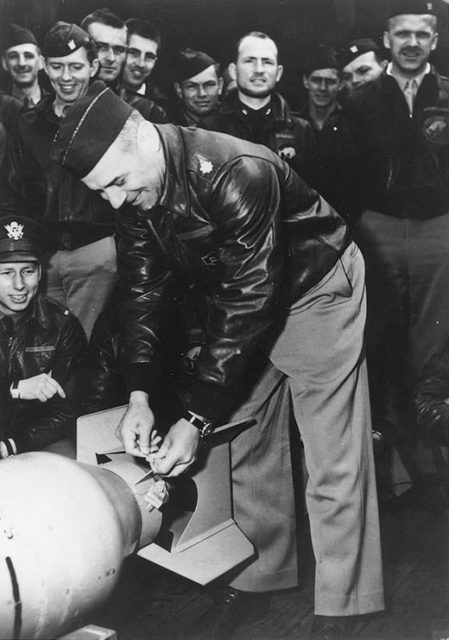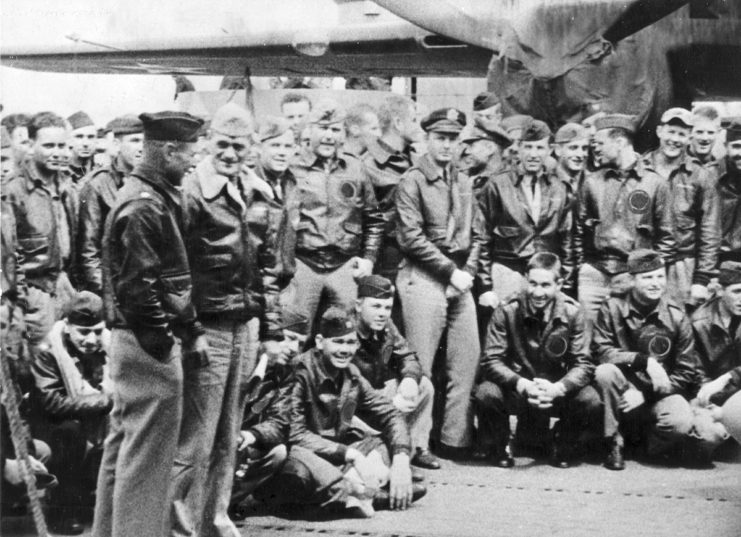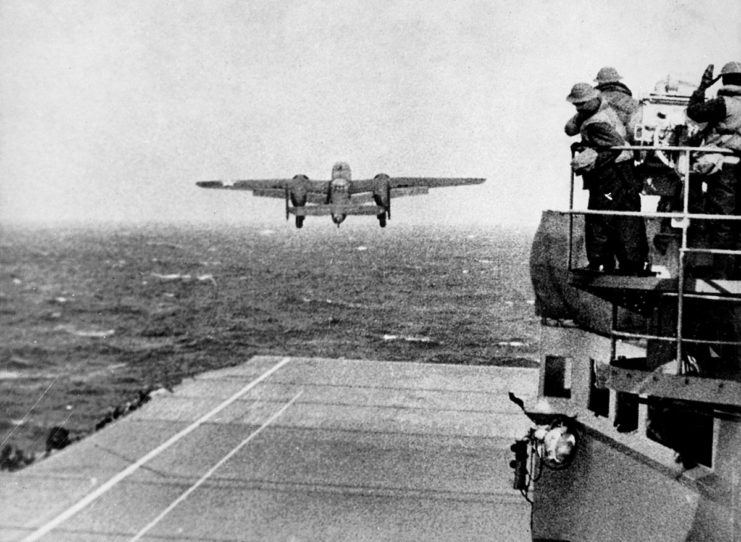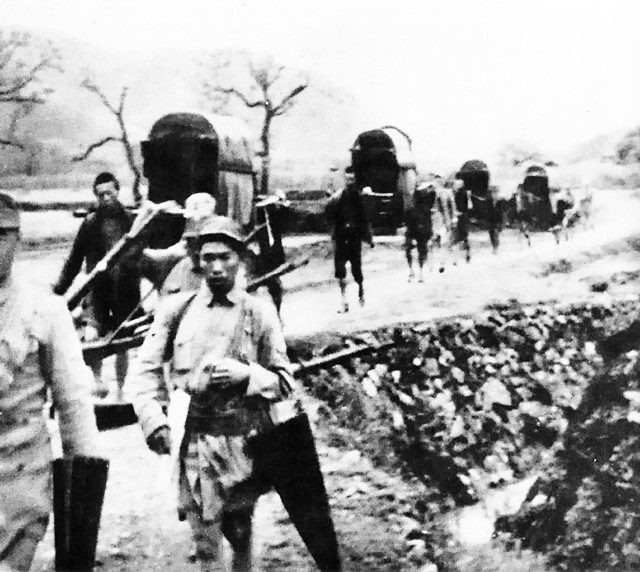Last week I had visited Eglin AFB and Checked Out the Armaments museum and they had a B25B in the mockup of the B25B that bombed Tokyo, so I decided to do a bit of research on the raid, I already knew a bunch about the raid because the Doolittle raid pushed the events that lead to the Battle of Midway that ended the dreams of Japanese domination in the Pacific War.
On December 21, 1941, two weeks after the Japanese attack on Pearl Harbor, US President Franklin D. Roosevelt told the American chiefs of staff he wanted Japan bombed as soon as possible. Following the shock of Pearl Harbor, American morale needed a boost. It would also be good to shake the Japanese faith in their leaders’ ability to protect them. In January, Captain Francis Low came up with the concept for what would become the Doolittle Raid. Having observed Army bombers, he believed they could be launched from aircraft carriers. It would enable a bomb load to reach Japan from a long distance away from the American fleet.
The raid was planned and led by Lieutenant Colonel James “Jimmy” Doolittle. A pioneering aviator, Doolittle had made tremendous contributions to instrument-based flying. He instigated moving away from the limitations imposed by using human senses in high-speed aerial combat.
Another one of my Pics, That airplane was "Skinny" and wasn't as big as I thought. For the first time I really noticed the size of the airplane.
This from Wiki
TB-25J-25-NC Mitchell, 44-30854, the last B-25 in the USAF inventory, assigned at March AFB, California as of March 1960, was flown to Eglin AFB, Florida, from Turner Air Force Base, Georgia, on 21 May 1960, the last flight by a USAF B-25, and presented by Brigadier General A. J. Russell, Commander of SAC's 822d Air Division at Turner AFB, to the Air Proving Ground Center Commander, Brigadier General Robert H. Warren, who in turn presented the bomber to Valparaiso, Florida Mayor Randall Roberts on behalf of the Niceville-Valparaiso Chamber of Commerce. Four of the original Tokyo Raiders were present for the ceremony, Colonel (later Major General) David Jones, Colonel Jack Simms, Lieutenant Colonel Joseph Manske, and retired Master Sergeant Edwin W. Horton. It was donated back to the Air Force Armament Museum c. 1974 and marked as Doolittle's 40-2344
The B-25B Mitchell medium bomber was chosen for the mission. The best
aircraft for the job, the B-25B needed to be fitted with extra fuel
tanks for the unusual long-range mission. Other modifications included
removing a gun turret, adding de-icers for the long high-altitude
flight, and adding extra blast plates.This from Wiki
TB-25J-25-NC Mitchell, 44-30854, the last B-25 in the USAF inventory, assigned at March AFB, California as of March 1960, was flown to Eglin AFB, Florida, from Turner Air Force Base, Georgia, on 21 May 1960, the last flight by a USAF B-25, and presented by Brigadier General A. J. Russell, Commander of SAC's 822d Air Division at Turner AFB, to the Air Proving Ground Center Commander, Brigadier General Robert H. Warren, who in turn presented the bomber to Valparaiso, Florida Mayor Randall Roberts on behalf of the Niceville-Valparaiso Chamber of Commerce. Four of the original Tokyo Raiders were present for the ceremony, Colonel (later Major General) David Jones, Colonel Jack Simms, Lieutenant Colonel Joseph Manske, and retired Master Sergeant Edwin W. Horton. It was donated back to the Air Force Armament Museum c. 1974 and marked as Doolittle's 40-2344

On the morning of the 18th, a Japanese picket boat spotted the American task force and radioed an attack warning. The American ships quickly destroyed the vessel.
Rather than let the Japanese make use of their warning, Doolittle decided to launch the raid ten hours early. It meant flying an extra 170 nautical miles.
The planes had never taken off from a ship before, but every pilot succeeded. By 0920, all 16 were in the air.
Flying first in groups, then individually and low over the sea to avoid detection, the planes sped toward Japan.

It was noon in Tokyo when the planes arrived. Although the Japanese had carried out air raid drills, they had never been seriously threatened by Chinese planes in a decade of sporadic war. That was about to change.
Anti-aircraft fire and fighter planes greeted the bombers. However, the aerial defenses of Tokyo were light, and the city was unprepared for a real attack. The crew of the B-25 Whirling Dervish shot down one fighter. The crew of the Hari Kari-er got two more. Some of the weaponry had been removed from the planes to make them lighter, but they had fake guns in the tail cones, which dissuaded the Japanese from attacking them from below.
The Fake guns on the B25B, This was my pic from last week
One B-25 received slight damage from anti-aircraft fire. Another
dropped its bombs early to avoid being hit. None of them were shot down.The bombers dropped their loads on 16 industrial and military targets, most of them in Tokyo. They also used their guns to strafe military positions.

Having dropped their bombs, the planes were to fly southwest, toward landing fields in China. There, they were to refuel before heading home.
One of the planes was too low on fuel. Instead, it headed for the Soviet Union and landed at an air base 40 miles from Vladivostok. The Russians were not at war with the Japanese. Under the terms of their neutrality pact, the Russians were obliged to intern the American crew. They were imprisoned near the Iranian border. Eventually, they bribed a smuggler to get them out and across the border, reaching the British consulate in May 1943. It later emerged that their escape had been engineered by the Russians to get around an awkward diplomatic issue.
The other 15 planes headed for China as planned. The early launch of the mission had also left them low on fuel. As bad weather descended, it became evident they would not make it to their landing fields before they ran out of fuel. They would have to abandon their planes when they reached the coast of China.
All fifteen crew members successfully abandoned their aircraft. Three of the B-25s were ditched at sea. The rest crashed on land. Only three men died in the crashes.
Japanese troops captured eight of the crewmen. Of them, three were executed, and one died in captivity. The rest escaped, with the help of Chinese soldiers and civilians. Many of the civilians risked their lives to do it and were punished by the occupying Japanese.

The public reaction, however, proved that for Americans, the outcome was worth the cost. The Doolittle Raid was a huge boost to public morale. Doolittle was promoted straight to brigadier general, skipping the rank of colonel. Every man who took part in the raid was awarded the Distinguished Flying Cross. Doolittle was given the Medal of Honor.
The raid killed 87 people in Tokyo and injured 462. Some of the casualties were children, enraging the Japanese public.
Fearful of another strike against their cities, the Japanese determined to seize Midway Island. They were defeated.
The Doolittle raid had done its job. American spirits had been lifted. Japanese nerves were shaken. The Empire of Japan lay vulnerable at last.



I never seem to get tired of reading or watching documentaries about the Doolittle Raid...........
ReplyDeleteGreat recounting of the raid. I always love watching B25s flying at air shows.
ReplyDelete"Sally" Crouch was one of my Masonic lodge brothers. He said one time that the reason he volunteered was he got to go home to his wife (They trained in Columbia, SC) for the mission. Great gentleman.
ReplyDelete